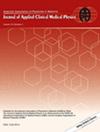High spatial resolution dosimetry for radiation oncology with “MagicPlates,” a new 976-pixel monolithic silicon detector
Abstract
Purpose
We introduce the next generation of “MagicPlate” 2D monolithic pixelated semiconductor detectors – MagicPlate-976 (MP976). It features a larger array area, higher spatial resolution, and does not require external triggering. We perform a comprehensive characterization for small-field steep-dose-gradient dosimetry applications in radiation therapy focusing on x-ray beams used in stereotactic treatments.
Methods
The MP976, developed by the Centre for Medical Radiation Physics, consists of 976 ion-implanted diodes on a thin n-type epitaxial silicon substrate with a total array area of 58 × 58 mm2. The central region has “small” diodes with an area of 0.2 × 0.2 mm2 and 1 mm pitch and the peripheral region has “large” diodes with an area of 0.6 × 0.6 mm2 and 2 mm pitch. The detector was primed with 10 kGy (Co-60) and tested using a Varian TrueBeam linear accelerator for sensitivity change and dose linearity, and variations in response due to dose-per-pulse and beam incidence angle. Output factors, depth dose, and beam profiles were measured and compared with reference data.
Results
After the 10 kGy, the sensitivity declined by (74 ± 5)% for “large” diodes and by (78 ± 7)% for the “small” ones, the dose-per-pulse (DPP) dependence was in the range of commercially available diodes, however, a difference in the DPP dependence between the “large” and “small” diodes of (8.4 ± 0.2)% was found in the studied DPP range from 0.131–1.111 mGy/pulse. The minimum angular response was at 90° for 6 MV and 100° for 10 MV flattened beams (76% and 82%, respectively). The output factors and depth dose response showed agreement with the reference within 3.1% and 1%, respectively. Deviation in small field 80%/20% penumbra measurements was within 0.5 mm for 6 MV FF and 0.3 mm for 10 MV FFF. Full width at half maximum (FWHM) for the beam profiles agreed within 0.5 mm for both beam qualities.
Conclusion
The new MagicPlate-976 detector system is shown to be suitable for dosimetry in small fields and steep dose gradients. It provides 1 mm spatial resolution in the central region and 2 mm on the periphery and has no dependence on the field size. The system's high spatial and temporal resolution opens new opportunities for trigger-less, film-less, and time-resolved verification and error identification for complex stereotactic treatment plans.


 求助内容:
求助内容: 应助结果提醒方式:
应助结果提醒方式:


